How to Make a Mold of a Missing Furniture Piece?
What Causes Mold on Furniture?
Mold growth on article of furniture is caused by backlog humidity or saturation due to moisture carpet.
Is the mold growing on the behind of piece of furniture near an exterior wall?
This is caused by a combination of poorly insulated exterior walls and elevated indoor humidity. If a firm is very well insulated (i.e. a modern ii×half dozen wall) this kind of mold growth will simply occur in homes with extremely high humidity. In older homes with poor or no insulation, this tin can happen in fairly dry houses.
My exterior walls are non insulated
No surprise here, the best solution is to insulate the walls via blown in insulation. Check your local utility company for rebates and discounts. If insulating the walls isn't feasible, you can however address the mold issue by pulling the furniture away from the walls and increasing the ventilation and temperature.
My outside walls are well insulated
Focus on lowering the indoor humidity (<50% in the winter). You can attain this by a combination of increasing the ventilation. The least expensive way to pull this off is typically past running your bathroom exhaust fan continuously.
Is the mold growing on furniture in the middle of the room?
This is caused by farthermost humidity (70%+). If you alive in a hot/humid climate, you'll demand to utilise your air conditioner to drop the humidity. If you lot live in a cool climate (and the problem occurs in the winter), y'all can lower the humidity by improving your ventilation and raising the heat.
You'll need to purchase a relative humidity gauge to monitor the RH. Your goal is to keep the winter RH below 50%.
Example of Interior mold growth due to furniture placed too close to a poorly insulated exterior wall
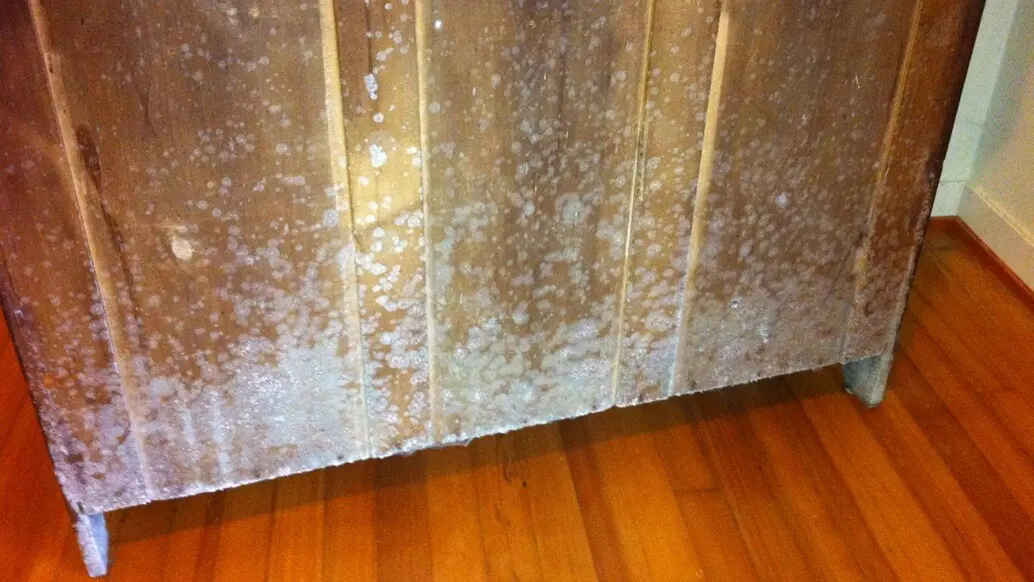
Mold growth on back side of dresser.
Mold growth on painted tabular array legs due to elevated humidity.
In this instance, the mold growth is likely feeding off the settled dust that has accumulated on the painted surface. Mold growth like this only occurs in rooms with very high humidity levels.
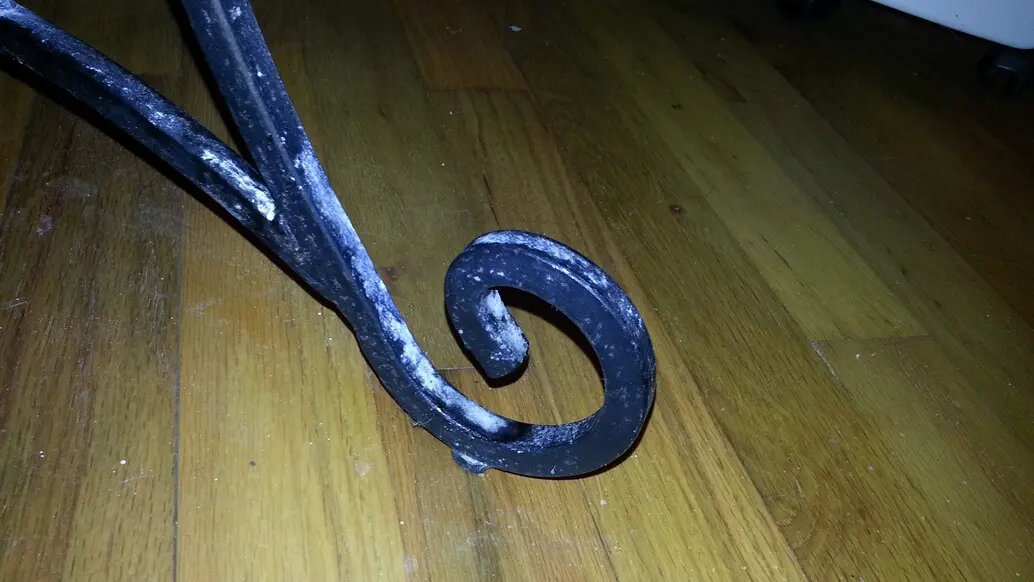
*Heads up – I earn a pocket-size committee on sales through Amazon links. This helps cover the expense of running the website (and answering your questions!)
Got a question? Ask it here and we'll postal service the answer beneath
Question:
What would cause mold on my dresser in a carpeted room?
The showtime goal is determining whether the mold is due to excess humidity or a liquid h2o leak/intrusion. In nearly cases, mold on the piece of furniture is due to a combination of excess humidity and poorly insulated outside walls. When a dresser is right against an exterior wall, the airflow is restricted and condensation can form. In time, this condensation creates an surround conducive to mold growth.
Try to go on your humidity below 55% during the winter months. Oft this tin can exist achieved by simply running your bath exhaust fan viii-12 hours per day. Also, if your home has poorly insulated walls, continue furniture and bedding 3-four″ away from all exterior walls. Lastly, be careful with humidifiers, which can greatly exacerbate the issue.
Question:
How tin can I clean the mold off the back of the dresser ? The back of my dresser looks like the one in your picture.
Typically a Borax / water solution works well. You're not relying on the killing power of solution, just rather the detergent/cleaning action. You'll demand to lightly scrub the surface to dislodge the mold growth. In many instances, some staining will remain in the wood. This is merely residual pigment and is not a health bug. Every bit e'er, wear a tight plumbing equipment respirator/mask to prevent inhalation of the spores you'll dislodge when cleaning. All cleaning should exist performed exterior of the home. Immediately launder all clothing worn during the cleaning procedure.
Question:
My daughter has a peel condition that reacts to warmth and lite. Living in a Florida home, we have central air at 68F, only besides a window ac unit running at all times in her bedchamber as she needs it at around 65F. She too has fans running on either side of her bed and coma curtains. Two days ago, I wiped down her furniture and changed all her bedding so I know everything was ok. ii days afterwards, I have discovered the top forepart of all her wooden dresser drawers, cloth Shadowbox, linoleum floor, dust ruffle on the opposite side of her bed from window ac unit. There is also a ceiling air conditioning duct in the ceiling about6 anxiety in front end of the dresser. What practice you think? Is there mold in the ceiling ducts? Is it the window ac? Both? Please give any advice as soon every bit you can. Do we call in a service? Who is reliable? Stanley Steamer had an advertisement for ductwork. Thank you so much. I don't know if I tin figure out how to download photos. Sincerely, John
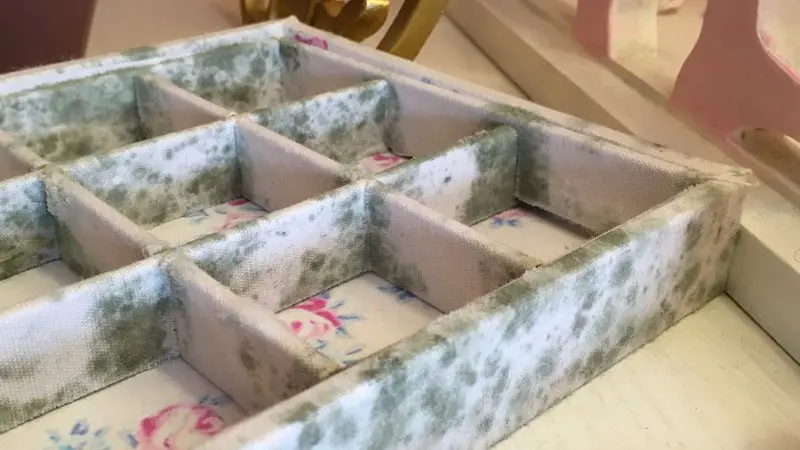
The amount of mold growth in the photo is quite severe. This type of mold is typically only found in rooms with highly elevated humidity. I recommend installing a relative humidity estimate. Your goal is to keep the RH below 55%. The lower the temperature, the higher the RH. We have a detailed explanation on our humidity page. Keeping the temperature at 65 degrees will atomic number 82 to higher humidity. This temperature may require the utilize of a dehumidifier. I would besides contact an HVAC company to evaluate your system. An air conditioning unit should lower the humidity in the home. Something is non working correctly.
Until the humidity trouble is addressed, any cleaning procedures will only yield temporary results.
Question:
How practise we clean this article of furniture? It'due south engineered wood.
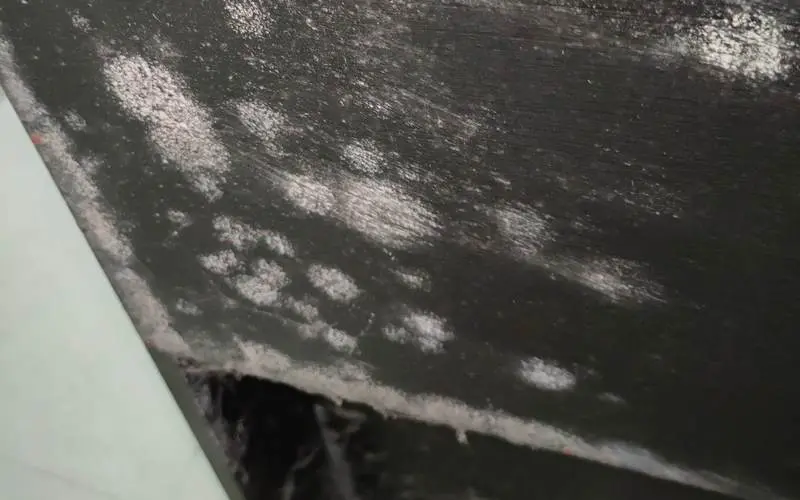
The cleanup procedure is the aforementioned as regular wood, but ensure you do non use excessive amounts of h2o. I recommend damp wiping the surface instead of vacuuming. The latter tends to aerosolize the mold particles throughout the room. When damp wiping, employ disposable paper towels and a basic detergent/cleaning solution. Y'all don't need to worry nearly the ability of the cleaner to 'kill' the mold, you lot're goal is to physically remove it from the surface.
Question:
I live in VA but accept been in MA for a few months taking care of my granddaughter. While information technology is cool in MA, information technology'southward still quite warm in VA. When my husband arrived home yesterday, he found mold on several pieces of piece of furniture. The a/c was off and there has been a lot of pelting there recently. I'thou somewhat surprised at the problem although I empathise why it happened (warm, stuffy, humid air with poor ventilation, PLUS we alive on the water). The couch in the picture I attached will be tossed, as it wasn't expensive. Even so, the residuum of the furnishings were more costly. My question is if it's worth trying to relieve any of the other pieces that are but starting time to evidence signs of arrayal. Should I simply make clean house and start again, or try to get things under control. My granddaughter will be there over Christmas and I'k scared for her wellness.
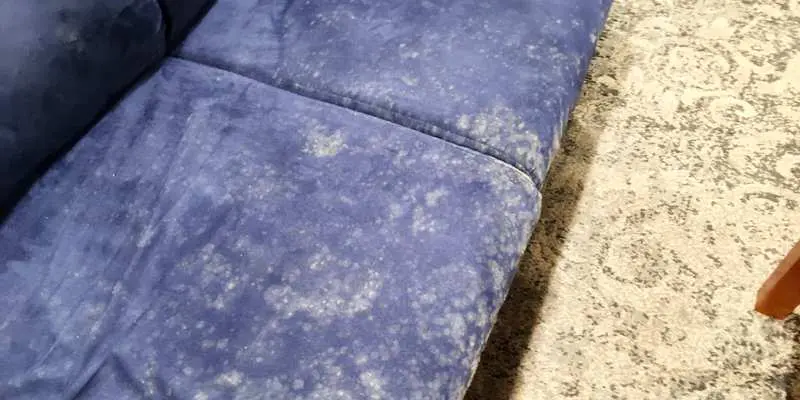
The mold growth on the couch is pretty extensive. Your intuition is correct, this should exist discarded. The ability to save the other article of furniture depends on the materials. If it's hard, non-porous items like woods tables, cleaning is fairly easy and there'southward little fear of lingering spores. If it's upholstered, the cleaning is much more difficult. I recommend HEPA vacuuming the furniture outside (or at least in a garage). Even the best HEPA vacuums featherbed a fairly large corporeality of spores into the air. Later cleaning, you could have a local mold inspector collect an air sample while you lot gently agitate the piece of furniture. This should give you a fairly skillful motion picture of whether you've removed the latent mold spores.
Question:
We were away this unabridged summer in Washington, DC, and establish white powdery mold (or mildew, non sure) on the couch in our basement. We may have had some water damage from a bad rainstorm in the adjoining room. Whatever idea what this is, and how to treat it? Thank you.
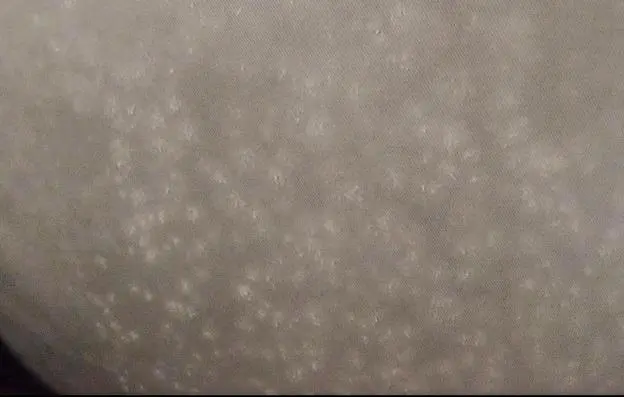
This is very likely mold growth. If the burrow is of low/moderate value, I would toss information technology out. In general, mold growth on porous items such every bit upholstered furniture is difficult to remove. If information technology'southward worth a off-white scrap, yous could endeavor to salvage it via HEPA vacuuming. Come across the response to the previous photo/submission for details on the cleaning process.
Question:
I live in the low desert, no humidity in the home. Why do I take mold on my woods furniture?
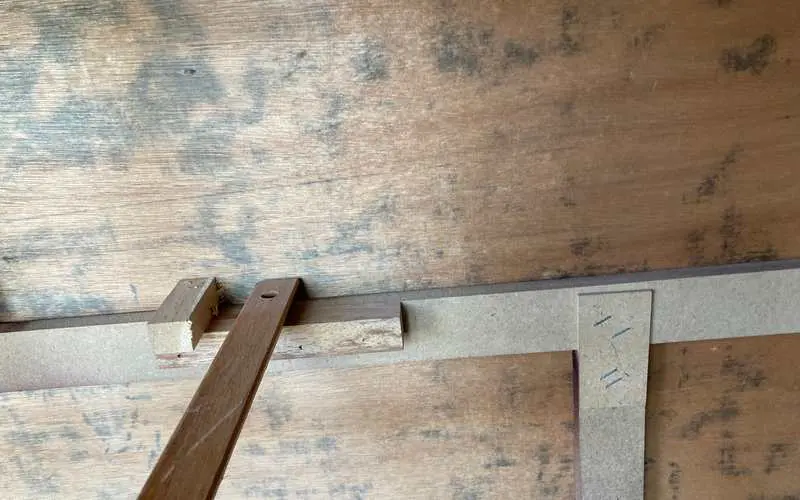
Due to the low humidity in your surroundings, this growth likely occurred at the factory. After the woods is dried, the mold growth stops. What you're seeing is the lingering staining from the prior growth. This is a adequately common issue with lumber and does not pose a health concern.
Question:
This is a picture of the bunk beds in my dwelling. The exterior walls are made of concrete blocks. The house is a riverfront property just the house is more than 50 yards from the water. It is only about 1000 foursquare feet. House has been closed about two months. I filed a claim with my insurance who had me pay for a company to come up out and exam for dampness. He said I had no water leaks and that the boiling levels were normal. I bought a 50 pint dehumidifier and the relative humidity stays around 68 to 70 in the hallway. The company said this is "most likely not mold" which means we are doing our own clean upwards. I become a headache when I go in the house and nosotros cannot live there. I tin't breath, can't stop sweating, and become excruciating headaches. It is growing on all of the furniture, on the inside of the kitchen cabinets, on the wrought fe, on the cloth furniture, and even in the puddle tabular array. I bought a fogger machine and the mold and mildew liquid to put in information technology. We fogged from the top in the attic space to every room in the firm. We are wiping all surfaces. I bought a mold kit from Lowe's and will be sending it in to come across what it really is that is growing in there. My grandson has asthma and just to go in to utilize the bathroom had him winded/sick. In your professional stance, is this a blazon of mold? I am also allergic to mold, fungus, etc per the results of my environmental allergy examination. It doesn't brand sense to go on paying for a business firm that we tin can't live in. Oh, this house don't have a crawl space. I tin can send additional pictures. Thanks for any help yous can give.
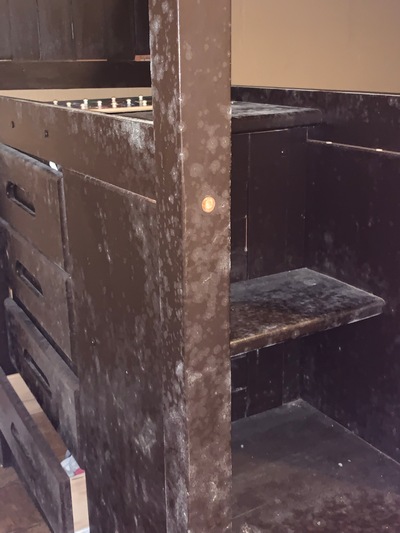
This is well-nigh certainly mold growth. Occasionally a white substance tin can occur due to efflorescence, but this only happens on masonry, concrete, etc. The widespread pattern of growth indicates high humidity throughout the room. This tin can exist caused past poor ventilation, inadequate air conditioning or a flooding upshot. If there are no signs of a flooding issue, it's due to humidity. In regards to the insurance visitor's claim the humidity levels are normal, this could but be due to the timing of the inspection. It's quite possible the growth occurred during a high humidity menses merely the levels had returned to normal the day the insurance adjuster visited the abode. Mold growth volition get inactive when the humidity/wet levels return to normal, but the visible growth will not disappear.
Verifying whether or non the substance is mold growth can exist accomplished with a simple record lift sample. Any local inspector or lab should be able to achieve this for a small fee.
Assuming the testing results come up back positive, the extent of the growth warrants professional remediation/cleaning. The difficult surface items, such as the forest bed frame, can be damp wiped with a mildicide. Porous items such as material article of furniture and the pool table volition require HEPA vacuuming, and if unsuccessful, replacement.
Question:
My wardrobe is fabricated of engineered forest and information technology has white powdery fungus. No affair how much I clean it off information technology keeps coming back. Any permanent solution to this??
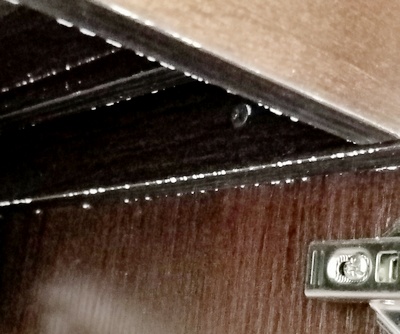
The only permanent solution is to lower the relative humidity (FH). A mold resistant coating will eventually fail, due to the accumulation of dust on top of the coating. You'll need to both monitor the RH and implement a solution decrease those levels.
Monitoring the RH, is relatively simple. Purchase an inexpensive RH approximate from your local hardware store or online. Place the device inside the wardrobe. Your goal is to continue information technology beneath 55%, and preferably, <l%.
Lowering the humidity is a fleck more tricky. If you live in a humid climate, yous'll need either a dehumidifier or air workout. If you already have AC, rent a local technician to evaluate the arrangement to ensure it is operating properly. If it'due south working correctly, information technology should dramatically lower the humidity in the dwelling house.
If y'all don't have air conditioning, a dehumidifier can aid. Yet, they produce heat, which tin be uncomfortable in a warm climate. If you live in a cool climate, the backlog rut tin can help heat the room.
Question:
I constitute this on my couch in the basement. I'thousand planning to throw abroad the cheap furniture simply the basement has carpet. I'chiliad nervous about mold in the carpet. Thoughts? Should I take it cleaned? If then with what?
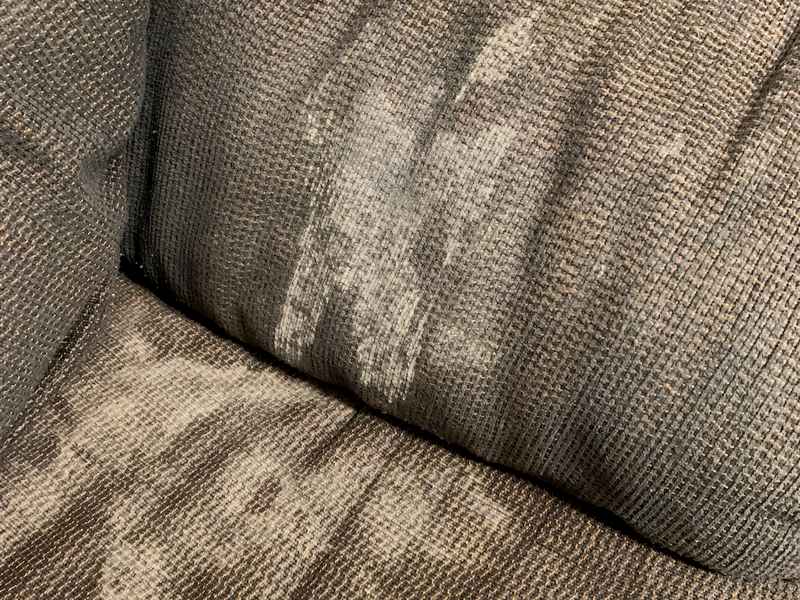
Y'all are correct, this couch should be discarded. Information technology's very difficult to fully remove the mold growth from the upholstered furniture. This growth points to an overall problem of elevated humidity. I recommend purchasing a relative humidity gauge. Monitor the area and see if the RH rises above 55%. If it does, and I assume it volition, you'll need to lower the humidity.
In the winter months, you'll need to focus on two items. Commencement, increase the airflow to the basement. Stagnant air will atomic number 82 to college levels of moisture. This tin can be accomplished through a bath exhaust fan. If no fan is nowadays in the basement, consider installing a Panasonic wall fan (WhisperWall).
Next, you'll demand to increase the temperature. Equally the temperature rises in the basement, the humidity volition lower. The minimum temperature is determined by the target relative humidity. For example, if the RH is 65%, you'll demand to increase the estrus until it drops beneath 55%.
Question:
At that place is mold on all of my furniture. What should I exercise? I am worried I am inhaling it as well.
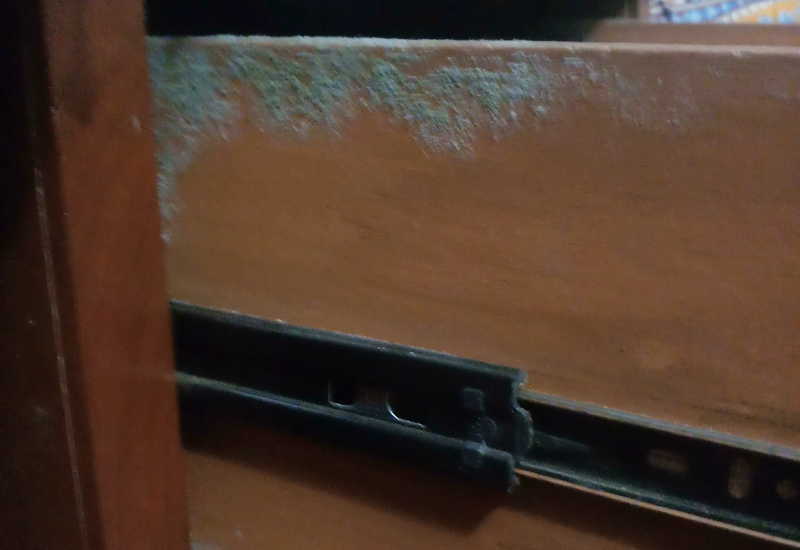
This style of mold growth is nearly always due to excess humidity in the dwelling. Your first step is to place the cause of the elevated moisture. If this is occurring during the winter months, information technology's due to poor ventilation. This can be remedied by increasing the rate of fresh air brought into the dwelling house. The to the lowest degree expensive technique is often to run the bathroom exhaust fan continuously.
Occasionally, the backlog moisture is due to water vapor coming up from the floor, either from the crawlspace or physical slab beneath. This tin can exist ruled out by inspecting the crawlspace and ensuring a vapor barrier is in identify. If the house is built on a concrete slab, apply a moisture meter to identify if water vapor is moving upward into the flooring.
If the mold growth is occurring during the summer months, you'll need to focus on your air conditioning organization. In climates with hot, humid summers, the air conditioner is critical for removing excess humidity from the home.
0 Response to "How to Make a Mold of a Missing Furniture Piece?"
Post a Comment